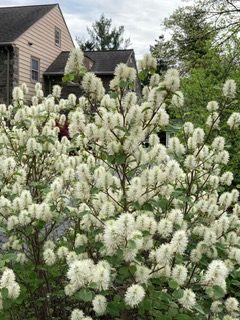Fothergilla gardenia or ‘Mt. Airy’ is sometimes called dwarf fothergilla and is native to the coastal plains of the Southern U.S. and is in the family Hamamelidaceae. Mt. Airy grows from 3 – 6 feet tall and does best in medium moisture with dappled sun. It prefers rich, acidic soil with good drainage but will tolerate some drought and wet areas.
The genus name honors Dr. John Fothergilla (1712-1780), an English physician and botanist who grew plants from around the world in his London garden. Mt. Airy is a hybrid fothergilla cultivar that was discovered by plantsman Michael A. Dirr at the Mr. Airy Arboretum in Cincinnati, Ohio. www.missouribotanicalgarden.org
Mt. Airy produces profuse spring flowers and provides excellent summer foliage and beautiful fall color. It has a consistently up-right habit but spreads extensively by suckering. Terminal bottle brush-like spikes (1-3 inches long) of tiny, fragrant and apetalous (having no petals) white flowers bloom in spring after foliage emerges. Flower color comes from the dense clusters of showy stamens (white filaments and yellowish anthers). The flowers are honey-scented, and in the fall the leaves turn yellow-orange and red-purple. Leaves are dark green and blue-gray underneath. www.missouribotanicalgarden.org
Mt. Airy has few pests and is rarely browsed by deer or rabbits. The fruit is an ornamentally insignificant two-seeded, beaked capsule that matures in the fall. Songbirds will eat the seeds, bees and pollinators visit the flower spikes.
Mt. Airy is a great specimen plant when allowed enough room to spread. It can be used as a foundation plant if the suckering is controlled. Mt. Airy is at home in a pollinator or native garden. www.plant.ces.NCSU.edu
You will find Mt. Airy in the Brunswick County Botanical Garden this spring.
Information and photos by Jeanne Pavero


